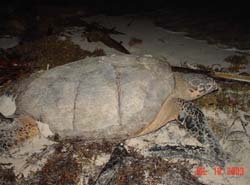Endangered sea turtles make a dramatic turnaround

Female hawksbill returning to sea <br>Credit: Wildlife Conservation Society
Poaching nearly eliminated in Central American nesting ground
Poaching of a critically important population of endangered hawksbill sea turtles along the coast of Nicaragua has dropped by more than 79 percent, thanks to a unique program developed by the Bronx Zoo-based Wildlife Conservation Society that enlists support from local communities, fishing groups, and government agencies.
Over a four-year period, the practice of illegally removing turtle eggs from nests has dropped from nearly 100 percent on several islands known as the Pearl Cays, to approximately 21 percent during 2002, according to the researchers, who published their results in the latest issue of the journal Chelonian Conservation and Biology.
“The Pearl Cays Hawksbill Conservation Project demonstrates how important local partners can be in protecting an endangered species such as the hawksbill turtle,” said WCS scientist Dr. Cynthia Lagueux, who has conducted research on turtle populations along the Nicaraguan coast for more than a decade. “Beach surveys and active protection of females and their eggs can make a difference for the survival of this endangered species in this part of the Caribbean.”
Weighing up to 200 pounds with a shell some 3 feet in length, the hawksbill turtle has vanished from many areas of its former range around the world. It is hunted for food, eggs and its valuable shell, which is commercially sold as “tortoise-shell” for use in eyeglass frames, hairbrushes, and a host of other fashion items. The species is listed as “critically endangered” by the World Conservation Union (IUCN). Further, hawksbill turtles are listed under Appendix I in the Convention on International Trade of Endangered Species (CITES), which bans all international trade.
The project’s engagement of local communities and government bodies started back in 2000, with meetings of nine communities with fishermen known to use the Pearl Cays area. These meetings provided the residents with biological information on hawksbills along with the results of their 1999 surveys. This in turn helped convince local people that losing all turtle eggs would eventually result in the species demise. Community leaders in support of the protecting the turtles were asked to sign a petition, while radio spots, written and performed by coastal residents, promoted the need to conserve hawksbill turtles and support the Pearl Cays Hawksbill Conservation Project.
While recent conservation efforts and educational outreach have been effective in increasing the number of hatchlings produced in the Pearl Cays, other threats have emerged, particularly habitat degradation of nesting islands by private individuals. The construction of buildings and other structures near or on beaches used by hawksbills destroys the vegetation and other conditions needed for successful reproduction.
“While we’ve enjoyed success in bringing more hawksbill turtles into the world, we also need to counteract threats to the habitats on which the species relies for reproduction,” added Lagueux. “A management plan is needed to keep development away from these critical sites.”
Media Contact
More Information:
http://wcs.org/All latest news from the category: Ecology, The Environment and Conservation
This complex theme deals primarily with interactions between organisms and the environmental factors that impact them, but to a greater extent between individual inanimate environmental factors.
innovations-report offers informative reports and articles on topics such as climate protection, landscape conservation, ecological systems, wildlife and nature parks and ecosystem efficiency and balance.
Newest articles

A blueprint for mapping melting ice sheets
Researchers in the Stanford Radio Glaciology lab use radio waves to understand rapidly changing ice sheets and their contributions to global sea-level rise. This technique has revealed groundwater beneath Greenland,…

Water hyacinth plant pots – utilization of an invasive species
Together with Fiber Engineering GmbH, the DITF presents a process for the production of biodegradable plant pots. The products are cost effective and competitive. At the same time, the production…

Current research on the new 6G mobile communications standard
Nursing care robots, autonomous driving, digital twins: all of these high-tech applications will play an essential role for the new 6G mobile communications standard. The first commercial 6G networks are…



